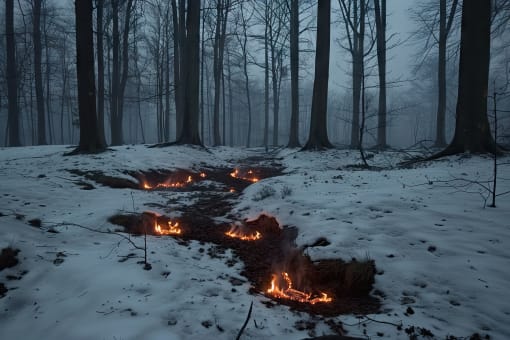Fires that do not die: The rising threat of zombie wildfires

2023 was a record-breaking year for Canada’s wildfire season, which saw a greater area burned across North America than ever recorded. Extended droughts and a warming climate have created drier than usual conditions providing fires with the fuel needed to burn stronger and longer.
More troubling is the rise of so-called zombie fires, named because of their unique characteristic of appearing to have been extinguished or dead, then sparking to life again once weather conditions permit. Until now there has only been a handful of these fires that continue to burn in the winter. However, 2024 is off to a menacing start with more than 100 fires still burning from 2023 that could become a serious problem for wildfire fighters in the months ahead.
The cause of these fires is still being studied. Researchers believe fires are sustained by carbon rich layers of soil, otherwise known as peat, smouldering under the blankets of snow. Findings also suggest that the fires may be kept alive in drier and denser forest due to woody tree roots. In either case, the result remains the same: given a prolonged dry stretch and just enough wind, the zombie fires can resurface, transitioning from smouldering to open flame.
In British Columbia, the weather for 2024 seems to be lining up perfectly for this. Weather experts predict an El Nino year for the province. This means we will continue to see a warmer winter, with a lower snowpack. As seasons change, the snowpack is expected to melt sooner allowing the ground to dry sooner. While people will love the longer summer, unfortunately this also means a longer fire season with a significant head start thanks to these zombie fires.
According to data from the Canadian Interagency Forest Fire Centre in early 2024, there are still 92 active fires in BC and another 54 in Alberta — holdovers from last year.
How can you proactively protect your property:
- Maintain a 1.5 meters non-combustible zone around your property.
- Clear debris from gutters including dead leaves and pine needles.
- Prune tree branches within 2 meters of the ground.
- Remove combustible materials from around the property. (i.e. firewood, furniture). This includes an adequate clearance zone of 30 meters from grassland and 100 meters from woodland and forest.
- Keep grass short, and the property adequately watered.
- Cover existing vent openings with 1/8” or 1/16” wire mesh”.
- Connect garden hoses to a hose bib or faucet.
How you can mitigate damages if a wildfire approaches your property:
- Turn on lights to increase visibility for firefighters.
- Place lawn sprinklers on roof tops.
- Close windows and doors, including interior doors.
- Prepare for evacuation by having a written evacuation plan and follow all government orders.




